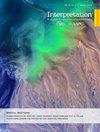HIDDEN HYDROSPHERE UNDER THE CASPIAN SEA: GEOPHYSICAL EVIDENCE AND SEA LEVEL INFLUENCE
IF 1.1
4区 地球科学
Q3 GEOCHEMISTRY & GEOPHYSICS
Interpretation-A Journal of Subsurface Characterization
Pub Date : 2022-11-30
DOI:10.1190/int-2021-0102.1
引用次数: 0
Abstract
We analyzed geologic-geophysical data, both from archives and collections in recent expeditions by the Shirshov Institute of Oceanology RAS (SIO RAS), and revealed many anomalies in the seismoacoustic wavefield. Anomalies are of two types: horizontal disturbed layers and vertical pipes. Anomalies form associations — pipes (chimneys) are rooted in disturbed layers and go through sediments up to the seafloor and form pockmarks. We consider all specified seismic anomalies and bottom microrelief as a possibility of vertical migration of gas and water via sediments (fluid from sediments to water and from seawater to sediments). It is expected that the fluids form a huge underground hydrosphere below the Caspian Sea. To test the fluid flow, we made a mathematical model of fluid discharge and absorption in bottom sediments. We hypothesize that the Caspian Sea level fluctuates, at least partially, due to cycles of the submarine ground water discharge and sea water absorption back into the sediments. This cyclicity of fluid discharge and absorption correlates with regional seismic events. The earthquakes cause tectonic relaxation, triggering the absorption process, and sea-level drop due to reverse flow into sediments. In other periods, the tectonic tension causes sediment compression and fluid discharge to sea water, which causes sea-level rise. The model was tested on the recent (past 100 years) sea-level change curve. As a result, we got a distribution of the general volume of fluid flows depending on the infiltration coefficient. The real change in the Caspian Sea volume is at the lower range of the calculated values, so we cannot neglect the effect of “gas pipes” (“chimneys”) on the Caspian sea-level change.里海下隐藏的水圈:地球物理证据和海平面影响
我们分析了来自Shirshov海洋研究所RAS(SIO-RAS)最近探险的档案和收集的地质地球物理数据,并揭示了地震声波场中的许多异常。异常有两种类型:水平扰动层和垂直管道。异常形成关联——管道(烟囱)植根于扰动层,穿过沉积物到达海底,形成麻点。我们认为,所有特定的地震异常和底部微起伏都是气体和水通过沉积物(从沉积物到水和从海水到沉积物的流体)垂直迁移的可能性。预计这些流体会在里海下方形成一个巨大的地下水圈。为了测试流体流动,我们建立了底部沉积物中流体排放和吸收的数学模型。我们假设里海水位波动,至少部分是由于海底地下水排放和海水吸收回沉积物的循环。这种流体排放和吸收的周期性与区域地震事件有关。地震引起构造松弛,引发吸收过程,并因逆流进入沉积物而导致海平面下降。在其他时期,构造张力导致沉积物压缩和流体排入海水,从而导致海平面上升。该模型在最近(过去100年)的海平面变化曲线上进行了测试。结果,我们得到了流体流动的一般体积随渗透系数的分布。里海体积的实际变化处于计算值的较低范围,因此我们不能忽视“天然气管道”(“烟囱”)对里海海平面变化的影响。
本文章由计算机程序翻译,如有差异,请以英文原文为准。
求助全文
约1分钟内获得全文
求助全文
来源期刊

Interpretation-A Journal of Subsurface Characterization
GEOCHEMISTRY & GEOPHYSICS-
CiteScore
2.50
自引率
8.30%
发文量
126
期刊介绍:
***Jointly published by the American Association of Petroleum Geologists (AAPG) and the Society of Exploration Geophysicists (SEG)***
Interpretation is a new, peer-reviewed journal for advancing the practice of subsurface interpretation.
 求助内容:
求助内容: 应助结果提醒方式:
应助结果提醒方式:


